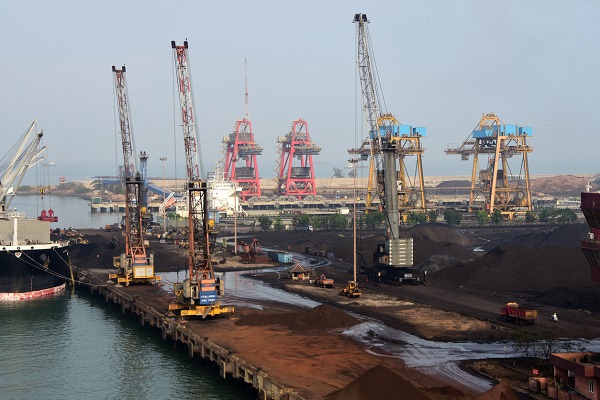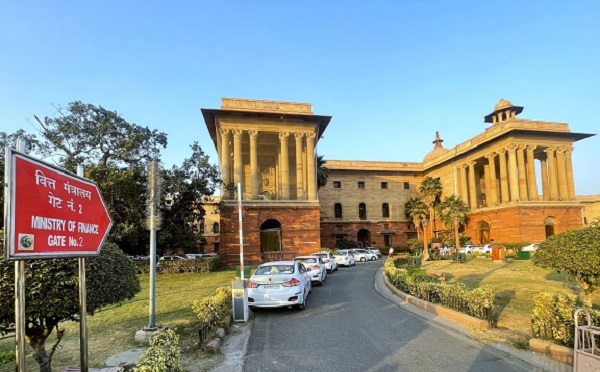.png)
Rangarajan Says India Must Not Dilute 3% Fiscal Deficit Cap
Rangarajan warns against replacing India’s 3% deficit anchor, saying it risks crowding out private investment and raising interest rates.


Kalyan Ram, a financial journalist, co-founded Cogencis and now leads BasisPoint Insight.
May 30, 2025 at 4:40 PM IST
Dr Chakravarthy Rangarajan, one of the architects of India’s original Fiscal Responsibility and Budget Management framework, has cautioned against replacing the country’s 3% fiscal deficit target with a more flexible debt-to-GDP anchor.
In a wide-ranging interview with BasisPoint Insight, the former Reserve Bank of India Governor said loosening the existing rule would crowd out private investment and push up interest rates by overstretching India’s already limited pool of household financial savings.
The present mandate of 3% for the Centre is the right one, Rangarajan said. “We should not dilute the Act.”
The warning comes at a time when the Finance Ministry is shifting to broader fiscal metrics, and the Sixteenth Finance Commission begins its work. Rangarajan, who chaired the 12th Finance Commission, argued that the combined 6% deficit ceiling for the Centre and states was calibrated around domestic savings. With household financial savings having fallen to 5% of GDP, loosening the cap could erode macroeconomic stability.
He added that excessive borrowing by the government would not only pre-empt private investment but also drive up interest rates, undermining both growth and credibility. One cannot have low interest rates and demand a larger share of savings for government borrowing, he said.
Beyond fiscal design, Rangarajan called on the Reserve Bank of India to clarify its communication around exchange rate management. While endorsing the central bank’s broad strategy of intervening to manage volatility, he said the term itself had become opaque.
Reducing volatility may be understood differently by different people, he said. At times, the RBI has aimed to slow the pace of depreciation, not just smooth fluctuations. Explaining this would help reduce confusion.
On monetary policy, Rangarajan backed India’s flexible inflation targeting regime but flagged the absence of a clear time frame to bring inflation back to the 4% midpoint. He said this flexibility could weaken policy accountability if inflation remains elevated for long stretches.
Calls to exclude food prices from the inflation target were misplaced, he argued, noting that headline inflation is what shapes household expectations.
Rangarajan also laid out a four-part strategy to meet India’s goal of a developed economy status by 2047. He called for raising the investment rate, adopting new technologies, boosting labour-intensive sectors, and expanding health and education. The approach, he said, must be multidimensional, unlike the export-led models that powered earlier growth stories in East Asia.
Public capital expenditure must remain high until private investment recovers, Rangarajan added, but warned against letting revenue expenditure spiral. You can’t raise both at the same time, he said.
The remarks come as policymakers weigh new rules for both fiscal and monetary policy. Rangarajan’s message is clear: don’t lose the discipline that took years to build.
Read the details of the interview conducted in Hyderabad.
Q: As India targets developed economy status by 2047, how do you assess the macroeconomic backdrop? What policy realignments are essential to stay on course?
A: The aspiration to become a developed country by 2047 has been articulated many times. There is no consensus on what constitutes a developed country. Most people go along with the World Bank’s definition of a high-income country, which means a country with a per capita income of $14,006 or more. For 2047, a colleague of mine and I have estimated this to be $18,414. On certain assumptions on exchange rate, population growth, etc, we conclude that India needs to grow at 7.41% per annum from now to 2047-48. This is a very big challenge.
India’s growth strategy to achieve this goal has to be framed against a background of world environment that is not very helpful. The big growth during 2005-08 happened against the background of a surging world trade. If world growth and trade come down in the coming decades, it will be harder to achieve this goal. Growth in India must rely on domestic demand.
The strategy of development cannot be unidimensional. It has to be multi-dimensional. Many of the East Asian countries, and perhaps China too, recorded high growth rates with an export-led strategy. That may not be possible now. We need to accelerate manufacturing, services and exports simultaneously.
Increasing the investment rate by two percentage points to support higher growth, absorbing new technologies to remain competitive, focusing on relatively more labour-intensive sectors to provide employment and expanding social infrastructure such as health and education to ensure social justice must form part of the development strategy.
Q: Sir, in the post-pandemic phase, the RBI has led the growth response while fiscal policy has remained conservative. With limited focus on redistribution, could this imbalance hurt consumption and undermine recovery?
A: In the context of the impact of COVID-19, the RBI injected liquidity in the system through various channels and kept the repo rate low. Subsequently, when inflation started to rise, and even crossed the upper limit of 6%, it tightened monetary policy and lowered it only when inflation started moving towards the target level of 4%.
As of now, it continues with that policy. Fiscal policy faced a much bigger challenge. The impact of COVID-19 meant lesser revenue at a time when more expenditure had to be incurred, both from the point of new health-related problems as well as stimulating the economy. The gross fiscal deficit of the Centre in 2021 was 9.16%, against the norm of 3% of GDP. The combined fiscal deficit of the Centre and states taken together in that year was 13.10% of GDP, twice the norm.
The high inflation in 2022 was a consequence of a liberal monetary policy and expansionary fiscal policy. One good thing that has happened in recent years in fiscal policy has been the rise in capital expenditures of the government.
Thus the ratio of revenue deficit to fiscal deficit has been coming down. This trend has been somewhat reversed in the current year’s budget. To promote growth, many steps are needed. Until private investment picks up, Central and state governments should keep their capital expenditures at a reasonably higher level. The pressure to raise revenue expenditures must be resisted. I have already indicated to you in the answer to your first question the elements that must form part of the development strategy.
Q: Sir, nearly a decade into inflation targeting, how do you assess its effectiveness? As the framework comes up for review, should it be refined to better account for factors like food inflation, which lie outside monetary policy’s direct control?
A: The framework that we have adopted is not rigid inflation targeting. It is a flexible inflation targeting. The monetary authority has been given the freedom to operate between 2% and 6% of inflation, even though the target of inflation is 4%. It may be viewed from one angle that it is too flexible because there is no time limit set to get back to 4%. In the recent period, the RBI has let inflation remain even above 6% for a considerable period.
In fact, even the inflation level of 4% is far higher than what the developed countries regard as an appropriate level. This has implications for the exchange rate of the rupee. We need to have some idea of the level of inflation beyond which it would begin to affect growth. If we want to exclude food inflation from the target level, then the target itself must be lowered. What is relevant for people is the overall headline inflation. If liquidity is increased, it affects food inflation as well. The demand we have to take into account is the demand in monetary terms. The flexible inflation targeting framework has given some precision to the concept of price stability. We must stay with it. There is no need to modify it.
Q: So you favour retaining the current framework. Are there specific refinements you would recommend in the upcoming review?
A: There are, I believe, some loose ends in the system that need to be addressed. As I said earlier, the framework doesn’t specify how long the RBI can remain outside the 4% target. This could allow monetary policy to drift in the 4–6% zone indefinitely. That is something we need to address.
Still, the basic principle—targeting 4% with a ±2% band—is appropriate. If you go back, it was the Chakravarty Committee, of which I was a member, that first suggested a 4% inflation target as being suitable for India.
Q: Sir, the RBI’s recent handling of the exchange rate has drawn criticism for mixed signals. In a world of shifting trade alignments and rising tariffs, what principles should guide India’s exchange rate management to ensure stability without eroding competitiveness?
A: We need to separate the issues related to exchange rate management from issues related to trade. On exchange rate policy, the stated position of RBI has been always that we are not committed to a particular rate and RBI’s interventions in the market are meant to reduce volatility. This is the right approach. Perhaps analysts are somewhat confused when RBI’s prolonged interventions may convey the impression of being tied to a rate. What is needed is a full explanation of what RBI means by reducing volatility.
Sometimes, RBI has intervened to moderate the rupee’s fall. Therefore ‘reducing volatility’ means not only reducing fluctuations around a given rate but also the pace of the rupee’s fall. Such a clarification may help to clear the doubts of analysts.
The world trade is in flux. Trump’s retaliatory tariffs have created great uncertainty. Free trade has come to a standstill. Benefits of world trade are getting reduced. The US is the world’s richest country. Its policies will have a big impact on overall flow of trade.
While this problem has to be tackled by each country negotiating with the US, countries other than the US will have to keep trade open. In this context, FTAs become necessary. The world will be broken up into different blocks. This is not ideal. This is the second-best solution.
Q: Sir, how do you view the RBI’s autonomy today, especially amid global concerns over central bank independence? Given rising public debt and fiscal pressures, is it time to revisit the FRBM framework you helped design?
A: Central banks and governments have common objectives. But the emphasis may differ at times. The clash usually is between the objectives of price stability and growth. Central banks normally are more sensitive to the price rises, that is, inflation. This is as it should be. What is needed is a continuous consultation between RBI and the government. Each institution must be governed by a set of rules. In India, we have now established a flexible inflation targeting mechanism to govern monetary policy. There are some loose ends in the mechanism which need to be tied.
The mandate is actually fixed by the government. Technically, the government can decide whether the target inflation rate is 4% or something higher or lower. Once the mandate is given, RBI must have full operational freedom. Similarly, as far as the Central Government is concerned, the Fiscal Responsibility and Budget Management Act was passed. This Act should guide actions of the government. Unfortunately, the Act has been more honoured in breach than in observance. Since the Act was passed, there has been only one year in which the Central government has abided by the mandate of the Act, that is, to contain fiscal deficit at 3% of GDP.
Some indications have been given that the government wants to amend the Act to move in a direction that will get away from 3% mandate. In my view, this is not correct. There is a strong logic behind the limit of fiscal deficit for Centre and States taken together to be at 6% of GDP. This is consistent with the available resources to meet the investment requirements of the government, public sector and private sector. To sum up, RBI has its own mandate that should not be sacrificed. As far as the government is concerned, the FRBM Act should be made more biting. We should not dilute that Act.
Q: Why, in your view, is shifting from a fiscal deficit target to a debt-to-GDP ratio problematic? What risks does such a move entail?
A: Because there are limited investable resources available in the economy. For instance, the financial savings of the household sector, a major source of investable funds, used to be around 7% of GDP. Now they have fallen to 5%.
If the Centre and states together borrow more than 6% of GDP, the question arises—where will the resources to finance private investment come from? It is meaningless to talk about encouraging private investment when the government is pre-empting a disproportionate share of savings.
Moreover, this excessive borrowing puts upward pressure on interest rates. You cannot have low interest rates and at the same time demand a large portion of savings for government borrowing. The FRBM Act’s original formulation understood these trade-offs clearly. That is why I believe strongly that we must not change the existing framework. It is sound in both logic and design.



